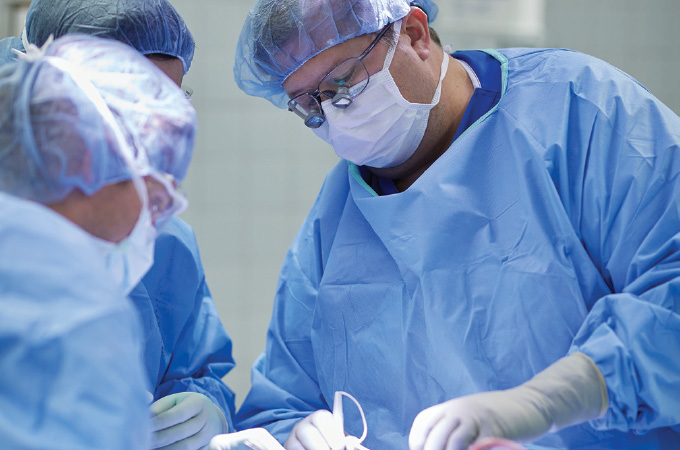The body’s blood vessels are amazing structures, but they are just as vulnerable as they are flexible and tough. Last fall, Thomas Podgorski of Webster Groves found out firsthand that they can harbor serious hidden problems that require expert medical attention.
One day in November, Podgorski felt a sudden, sharp pain in his back. It got worse, so he was taken to the hospital for evaluation. Imaging showed that he needed emergency surgery for a ruptured abdominal aortic aneurysm—a major defect in his aorta, the body’s largest blood vessel that passes through the middle of the abdomen. These aneurysms are life-threatening, so immediate treatment is essential, says SLUCare vascular surgeon Dr. Matthew Smeds, who performed the surgery at SSM Health Saint Louis University Hospital.
The aorta is under intense pressure because of its size and location, so a rupture can cause the patient to bleed out, Smeds explains. “When you cut your hand or foot, the blood usually can be controlled,” he says. “But when a major vessel like the aorta is damaged and has free space to bleed into, it doesn’t take long to lose a significant amount, and the person can die quickly.”
The site of the aneurysm also determined the type of surgery that could be done. Some patients receive a stent graft, but Smeds says Podgorski’s rupture was too close to his kidney arteries for that procedure. Instead, the damaged vessel was repaired with a prosthetic graft of Dacron, and Smeds says the results have been very positive. “We saw Thomas recently for a checkup, and things have been going well for him,” he notes.
Abdominal aortic aneurysms are most common in Caucasian men over age 65 who smoke, and family history can be a factor as well. The seriousness of the condition is a good reminder to avoid tobacco use, stay active and eat a healthy diet, according to Smeds. He and his fellow SLUCare physicians are highly experienced in treating vascular issues of all kinds. The practice sees patients with peripheral and carotid artery disease, varicose veins, vascular trauma and other conditions, putting the latest medical and surgical knowledge to work. A full complement of care helps patients heal and return to normal activities.
“I’ve been getting my strength and mobility back through physical therapy, and I’m feeling good,” Podgorski says. “It’s been a long road, but I’ve returned to many of the things I used to do, like looking after my grandchildren. Not long ago, I went back to the hospital’s intensive care unit to thank the staff members who cared for me. Just talking to them, I could tell how invested they were in my recovery. It was a very touching experience.”
SLUCare Physician Group treats vascular disease using the latest medical and surgical methods. Pictured on the cover: Vascular surgeon Dr. Matthew Smeds. For more information, call 314.977.6125 or visit slucare.edu/vascular.
Cover design by Julie Streiler | Cover photo courtesy of SLUCare Physician Group
Pictured at top: Vascular surgeon Dr. Matthew Smeds
Photo courtesy of SLUCare Physician Group
